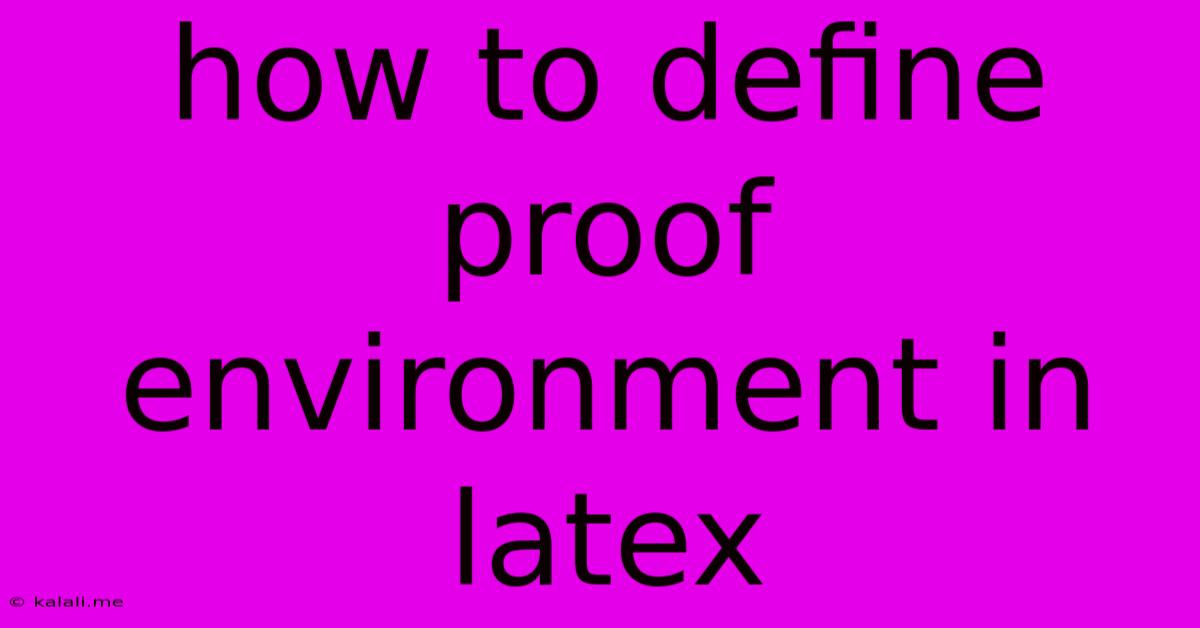How To Define Proof Environment In Latex
Kalali
May 25, 2025 · 3 min read

Table of Contents
How to Define a Proof Environment in LaTeX
This article will guide you through defining custom proof environments in LaTeX, enhancing the readability and structure of your mathematical documents. We'll cover creating simple proof environments, incorporating assumptions, and adding stylistic elements for a polished professional look. This is essential for anyone writing mathematical papers, theses, or any document requiring rigorous mathematical proofs.
Defining a custom proof environment allows you to standardize the presentation of your proofs, making them easier to read and understand. This improves both the reader experience and the overall quality of your document. We will explore several methods, from simple to more advanced, to cater to various needs and preferences.
Understanding the amsthm Package
The amsthm package is fundamental for creating and managing theorem-like environments in LaTeX, including proofs. It provides a robust framework for customization and ensures consistency in your document's style. Make sure to include this package in your LaTeX preamble using:
\usepackage{amsthm}
Creating a Basic Proof Environment
The simplest way to create a proof environment is using the \newenvironment command. This command defines a new environment with a specific beginning and ending. Here's how you can define a basic "proof" environment:
\newenvironment{proof}{\begin{proof}}{\end{proof}}
This code redefines the existing proof environment. While this works, it's generally better to use a more descriptive name to avoid confusion with other potentially existing environments, and to better organize your code. Let's create a new environment called myproof:
\newenvironment{myproof}{\begin{proof}}{\end{proof}}
Now, you can use \begin{myproof} and \end{myproof} to enclose your proof. The output will be identical to using the standard proof environment, but your code is organized better.
Adding a QED Symbol
The standard proof environment usually includes a QED (Quod Erat Demonstrandum) symbol at the end, indicating the completion of the proof. You can customize this using the \qedsymbol command. For instance, to use a filled square as the QED symbol:
\renewcommand{\qedsymbol}{$\blacksquare$}
Place this line before your environment definition. Remember to compile your LaTeX document after making changes.
Incorporating Assumptions and Hypotheses
Often, proofs rely on specific assumptions or hypotheses. You can elegantly integrate these into your proof environment. One approach is to add an optional argument to your environment:
\newenvironment{myproof}[1][]{\begin{proof}[#1]}{\end{proof}}
Now, you can include assumptions within square brackets:
\begin{myproof}[Assuming $x > 0$]
... your proof ...
\end{myproof}
This adds the assumption "Assuming $x > 0${content}quot; before the proof body, making your proofs clearer and more self-contained.
Adding Stylistic Elements
For enhanced visual appeal, you can adjust the formatting of your proof environment. You can change the font, indentation, or add a specific title. This requires more advanced LaTeX skills, often involving manipulating the amsthm package options, but provides a way to customize the look and feel of your proofs.
Conclusion
Defining custom proof environments in LaTeX not only streamlines your workflow but also significantly improves the readability and professionalism of your mathematical documents. By mastering these techniques, you can create consistent and elegant proofs, enhancing the clarity and impact of your work. Experiment with the techniques described above to find the style that best suits your needs. Remember to always consult the amsthm package documentation for more advanced customization options.
Latest Posts
Latest Posts
-
How Much Is 25 20 Dollar Bills
Jul 05, 2025
-
How Many Apples In 3 Lb Bag
Jul 05, 2025
-
What Is Half A Quarter Of 400
Jul 05, 2025
-
How Do You Make A Vegetable Necklace
Jul 05, 2025
-
How Many 750ml Are In 1 75 Liters
Jul 05, 2025
Related Post
Thank you for visiting our website which covers about How To Define Proof Environment In Latex . We hope the information provided has been useful to you. Feel free to contact us if you have any questions or need further assistance. See you next time and don't miss to bookmark.